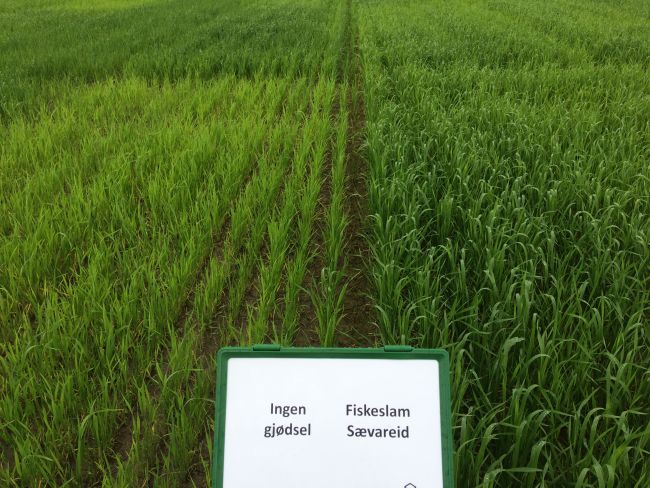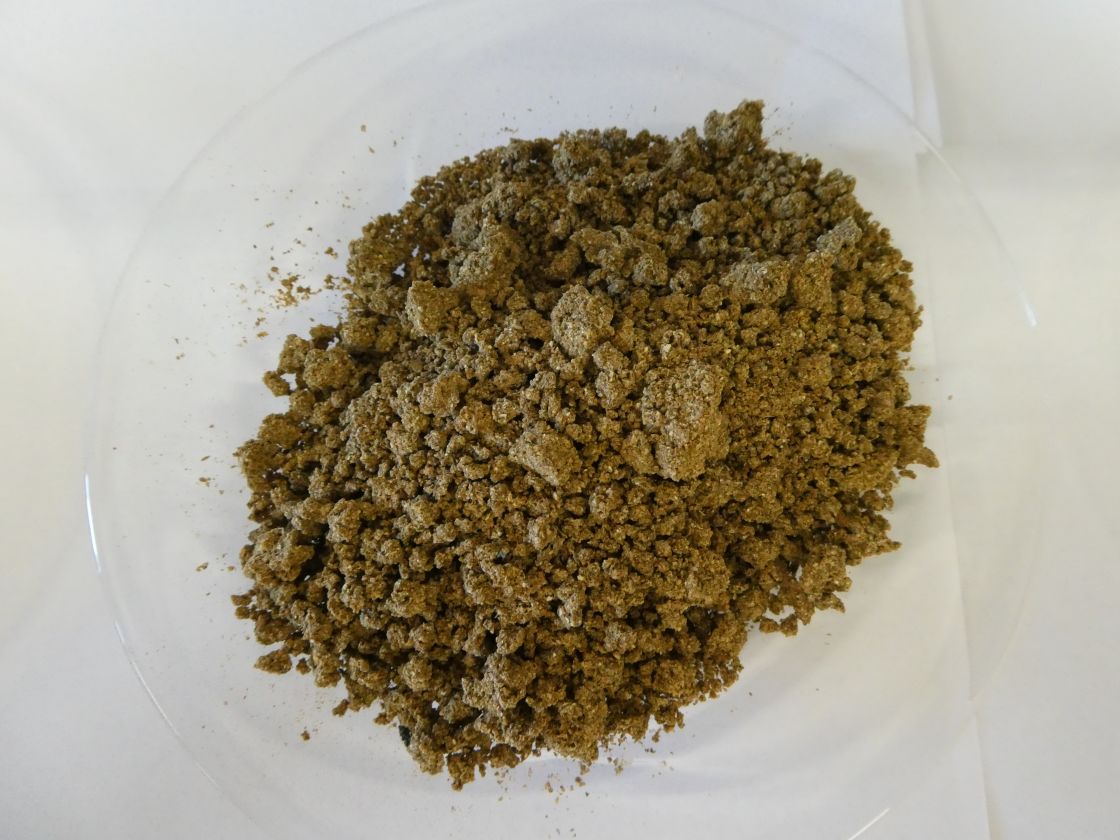
Dried Fish sludge - the farmer's new gold?
Eva Brod, Researcher at NIBIO
Nr.1 2025
Fish sludge has significant potential as a fertilizer and, with the right choices, can shift from being a waste problem in the blue sector to becoming a valuable resource in the green sector.

This article can be downloaded as a PDF at the Fjell Tech agenda homepage - Download center.
Fish sludge, consisting of feed residues and excrements, is a nutrient-rich organic waste product from the fish farming industry. Land-based fish farms already face challenges in managing and utilizing fish sludge, which they are obliged to collect due to emission permit requirements. With expanding aquaculture production and stricter environmental regulations, even more sludge is expected to be collected, also from post-smolt and on-growing facilities on land and in sea.
In a circular bioeconomy, fish sludge should be utilized as a resource and returned to the nutrient cycle. Our research shows that, with the right treatment and choices, dried fish sludge can become a viable resource in bio-based fertilizers.
Fish sludge as a fertilizer alternative
Using dried fish sludge as fertilizer on agricultural land is a natural and sustainable solution. Its phosphorus content is particularly important, as global reserves of phosphate rock are limited. Phosphate rock is essential in the production of mineral fertilizers.
As salmon feed becomes increasingly plantbased, aquaculture’s dependence on mineral fertilizers also grows. It is therefore vital that the industry takes responsibility for recycling phosphorus from fish sludge. In contrast to mineral fertilizers, fish sludge also contains organic matter, which can improve soil structure
Feed residues vs. excrements
The ratio of uneaten feed to excrements in fish sludge largely determines its nutrient composition and quality as fertilizer. Fish sludge collected at land-based hatcheries contains about 50% uneaten feed on average, but the variation is large (Aas et al. 2016).
Lower contents of feed residues in fish sludge reduces fat, nitrogen and energy levels while increasing ash, phosphorus and heavy metals. This results in lower levels of readily available nitrogen, the key nutrient for plant growth. Although sludge with more feed residues is a better fertilizer, from a resource perspective it must be an overall goal that as much feed as possible is turned into fish instead of fish sludge.

Author Eva Brod at crop field fertilized by fish sludge.

Fertilizer regulation
Norwegian fertilizer producers can choose to market their products under the Norwegian fertilizer regulation or the European fertilizer product regulation (FPR (EU) No. 2019/2009). Since fish sludge is not included in the EU regulation, it can currently only be marketed under the Norwegian fertilizer regulation.
The Norwegian fertilizer regulation is divided into two parts. The ’Fertilizer Product Regulation’ (FOR-2025-01-29-116) sets quality standards for fertilizer products, whereas the ’Fertilizer Use Regulation’ (FOR-2025-01-29-115) governs storage and application.
Fish sludge must be sanitized to prevent disease transmission and stabilized to prevent odour, mould or environmental issues. Heavy metal concentrations determine a product’s quality class. Manufacturers are also responsible for ensuring safety regarding organic pollutants and other substances that may cause damage to health or the environment.

Table 1 Selected parameters analysed in dried fish sludge in the period 2010 to 2023.
From 2025 phosphorus application rates on agricultural land have been restricted. The maximum application rate of a bio-based fertilizer is determined either by its phosphorus or heavy metal content, depending on which threshold is reached first. Given its high phosphorus content, fish sludge is usually regulated by phosphorus levels.
Nitrogen determines plant growth
Among the three main essential nutrients, nitrogen, phosphorus and potassium, nitrogen is the most critical for crop yields. On a dry matter basis, dried fish sludge contains approximately as much total nitrogen as manure from cattle, pigs or chickens (Table 1; Daugstad et al. 2012). However, nitrogen content varies widely between fish sludge products, even from the same fish farm.
Only about 3% of total nitrogen in dried fish sludge is directly plant-available (Table 1). Most of the nitrogen is organically bound, since ammonium is lost during dewatering and drying. The carbon and nitrogen ratio (C/N ratio) in fish sludge indicates how quickly the organically bound nitrogen becomes plant-available. Fish sludge with a lower C/N ratio provides more effective nitrogen fertilization.
In a field trial with grain, dried fish sludge with a C/N ratio of 15.5 had only 7% of the nitrogen effect of mineral fertilizer, while fish sludge with a C/N ratio of 6.8 had a relative nitrogen fertilization effect of 48% compared with mineral fertilizer (Brod et al. 2023).

Field experiment: Although fish sludge contains a lot of nutrients, the fertilizer effect is variable. This is because most of the nitrogen in the sludge is not directly available to plants. Fish sludge is still worth investing in, as it adds organic matter to the soil, and can, depending on its quality, replace a larger or smaller part of mineral fertilizer. Left side: No fertiliser, Right side: Fish sludge from Sævareid used as fertiliser. Photo: Anne Falk Øgaard
Phosphorus: High quantity, low availability
Despite its high phosphorus content, only a small fraction of the phosphorus in fish sludge is plant-available. In greenhouse trials with barley, three dried fish sludge products provided between 28 and 52% of the phosphorus effect of mineral fertilizer (Brod & Øgaard 2021). The average phosphorus effect of the fish sludge products was lower than those from livestock manure, and did not improve significantly in the following season.
Plants take up phosphorus as dissolved phosphate. Most of the phosphorus in dried fish sludge is bound in poorly soluble calcium phosphates. Treatment of the fish sludge could improve its solubility, but we have not yet carried out systematic studies to investigate this further.
Towards a balanced fertilizer product
The nutrient composition of dried fish sludge is poorly balanced compared to the plants’ needs.
Ammonium and potassium are water-soluble and are largely lost during dewatering. Ammonium can also evaporate during drying. This results in a low nitrogen to phosphorus (N/P) ratio, leading to underfertilization with nitrogen, especially if the actual nitrogen effect is considered.

Dried fish sludge: The fertilizer quality of this dried fish sludge product was examined in both field trials, greenhouse trials and in the laboratory. Photo: Eva Brod
In practical agriculture, the unbalanced composition of nutrients appears to be a major challenge. To address this, dried fish sludge can be combined with mineral fertilizer components, either by separate supply or by enrichment. Enrichment with nitrogen and potassium can balance the nutrient profile and make the product more suitable for agricultural use.
Zinc and cadmium
Zinc is both a necessary micronutrient and a potential contaminant. It is added to the fish feed for fish health and to replace antibiotics. Cadmium, on contrast, is a toxic heavy metal originating from marine feed ingredients.
Among 26 dried fish sludge samples analyzed between 2010 and 2023, half were in quality class I and II according to Norwegian fertilizer regulations due to elevated zinc or cadmium concentrations (Table 1). All fish sludge samples were still limited by their phosphorus concentration, not by their heavy metal concentrations.
Even though the zinc and cadmium concentrations were within permissible limits, efforts should be made to further reduce them, to protect food safety and increase farmers acceptance.
A new export industry?
Agricultural fields near fish farms often already have high levels of plant-available phosphorus (P-AL) due to longterm manure use. These soils do not need extra fertilization with phosphorus in fish sludge. However, in Eastern Norway’s grain regions, where there has been little use of animal manure for a long time, fish sludge could be a valuable fertilizer. Recent initiatives aim to approve fish sludge as a fertilizer product also under EU regulations. Regardless, efficient transport will be essential for large-scale use.
Organic fertilizer based on fish sludge can form the basis for a new industry enhancing aquaculture’s environmental credentials. Success will depend on considering quality, not only of the fish but also the fish sludge, along the entire value chain.

References
Brod E, Henriksen TM, Ørnsrud R, Eggen T (2023) Quality of fish sludge as fertilizer to spring cereals: Nitrogen effects and environmental pollutants. Science of the Total Environment 875: 162541
Brod E & Øgaard AF (2021) Closing global P cycles: The effect of dewatered fish sludge and manure solids as P fertiliser. Waste Management 135: 190-198
Daugstad K, Kristoffersen AØ, Nesheim L (2012) Nutrient content in animal manure. Analysis of manure from cattle, sheep, pigs and poultry 2006-2011.
Bioforsk Report 7 (24) 29 pages Aas TS, Ytrestøyl T, Berge GM (2016) Dry matter content in sludge from land-based production of Atlantic salmon. Nofima Report 32/2016. 19 pages

Fjell Tech Agenda is a publication by Fjell Technology Group aimed at sharing knowledge with customers, partners, and stakeholders. Its purpose is to present complex topics in a clear and accessible format for non-experts. The publication is not intended to promote Fjell Technology Group’s products or services. All content reflects the views and insights of the individual author, and Fjell Technology Group does not assume responsibility for the opinions expressed.
Suggestions for future topics are welcome at post@fjelltg.com.
Happy reading!

Eva Brod, NIBIO
Eva Brod is a researcher at NIBIO, specializing in bio-based fertilisers. She completed her PhD in 2016 at NMBU, focusing on phosphorus recycling.